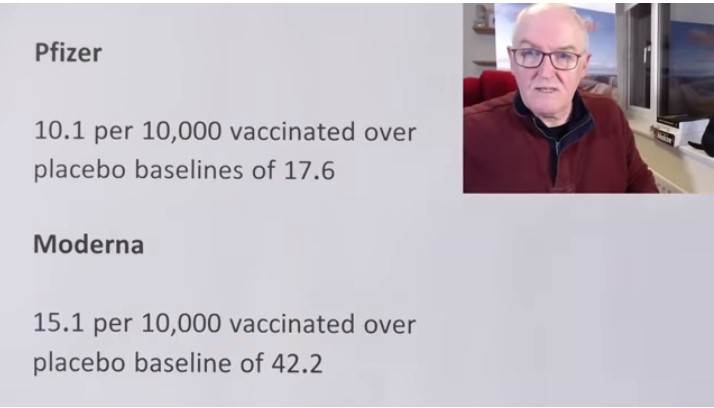COVID-19
Health researcher calls government promotion of Covid mRNA vaccines “confusing”

From (2079) Dr. John Campbell – YouTube
British Health researcher John Campbell has uncovered sobering and disturbing statistics regarding serious adverse events connected to covid vaccines.
As Campbell outlines in this presentation, multiple previous vaccines producing far fewer adverse events, have been withdrawn from public use while governments continue to promote covid vaccines.
(Campbell is well known for his meticulous research and he always includes links to the studies he is calling attention to. His presentation notes are below the video)
John Campbell’s research notes and links to relevant studies
Swine flu vaccine (1976), 1 serious event per 100,000 vaccinees,
Vaccine withdrawn Rotavirus vaccine
Rotashield, (1999),1 to 2 serious events per 10,000 vaccinees,
Vaccine withdrawn
Covid mRNA vaccines, 1 serious event per 800 vaccinees,
Vaccine officially promoted
Serious adverse events of special interest following mRNA COVID-19 vaccination in randomized trials in adults https://pubmed.ncbi.nlm.nih.gov/36055…
Free full text available https://www.ncbi.nlm.nih.gov/pmc/arti…
Why We Question the Safety Profile of mRNA COVID-19 Vaccines (Robert M Kaplan and Sander Greenland) https://sensiblemed.substack.com/p/wh…
Using publicly available data from Pfizer and Moderna studies, we found one serious adverse event for each 800 vaccinees. That translates to about 1,250 serious events for each million vaccine recipients.
US, Spain, Australia
Study to evaluate serious adverse events of special interest observed in mRNA COVID-19 vaccine trials.
Secondary analysis of serious adverse events reported in the placebo-controlled, phase III randomized clinical trials, of Pfizer and Moderna mRNA COVID-19 vaccines
Results Pfizer and Moderna mRNA COVID-19 vaccines were associated with an excess risk of serious adverse events
of special interest
Pfizer
10.1 per 10,000 vaccinated over placebo baselines of 17.6
Moderna
15.1 per 10,000 vaccinated over placebo baseline of 42.2
Combined, the mRNA vaccines Associated with an excess risk of serious adverse events of special interest of 12.5 per 10,000 vaccinated
Pfizer trial
Pfizer vaccine group 52 serious AESI (27.7 per 10,000) were reported
Pfizer placebo group 33 serious AESI (17.6 per 10,000) were reported
36 % higher risk of serious adverse events in the vaccine group
Risk difference 18.0 per 10,000 vaccinated
Moderna trial
Moderna trial, vaccine group 87 serious AESI (57.3 per 10,000) were reported
Moderna trial, placebo group 64 serious AESI (42.2 per 10,000) were reported
6 % higher risk of serious adverse events in the vaccine group
Risk difference 7.1 per 10,000 vaccinated
Discussion
The excess risk of serious adverse events found in our study points to the need for formal harm-benefit analyses, particularly those that are stratified according to risk of serious COVID-19 outcomes. These analyses will require public release of participant level datasets. Full transparency of the COVID-19 vaccine clinical trial data is needed, to properly evaluate these questions.
Unfortunately, as we approach 2 years after release of COVID-19 vaccines, participant level data remain inaccessible.
Level of adverse reactions in the past
The 1976 swine flu vaccine
Small increased risk of Guillain-Barré Syndrome
The increased risk was approximately 1 additional case of GBS for every 100,000 people who got the swine flu vaccine. When over 40 million people were vaccinated against swine flu, federal health officials decided that the possibility of an association of GBS with the vaccine, however small, necessitated stopping immunization until the issue could be explored.
The Institute of Medicine (2003) https://www.ncbi.nlm.nih.gov/books/NB…
Concluded that people who received the 1976 swine influenza vaccine had an increased risk for developing GBS. Exact reason for this association remains unknown.
Rotavirus vaccine Rotashield, (1999) https://www.cdc.gov/vaccines/vpd-vac/…
The U.S. Advisory Committee on Immunization Practices (ACIP) October 22, 1999 to no longer recommend use of the RotaShield® vaccine for infants, because of an association between the vaccine and intussusception. The results of the investigations showed that RotaShield® vaccine caused intussusception in some healthy infants Within 2 weeks Intussusception increased 20 to 30 times over the expected risk (Less after the second and third dose) CDC estimated that one or two additional cases of intussusception would be caused among each 10,000 infants vaccinated with RotaShield® vaccine.
COVID-19
Canadian Health Department funds study to determine effects of COVID lockdowns on children

From LifeSiteNews
The commissioned study will assess the impact on kids’ mental well-being of COVID lockdowns and ‘remote’ school classes that banned outdoor play and in-person learning.
Canada’s Department of Health has commissioned research to study the impact of outdoor play on kids’ mental well-being in light of COVID lockdowns and “remote” school classes that, for a time, banned outdoor play and in-person learning throughout most of the nation.
In a notice to consultants titled “Systematic Literature Reviews And Meta Analyses Supporting Two Projects On Children’s Health And Covid-19,” the Department of Health admitted that “Exposure to green space has been consistently associated with protective effects on children’s physical and mental health.”
A final report, which is due in 2026, will provide “Health Canada with a comprehensive assessment of current evidence, identify key knowledge gaps and inform surveillance and policy planning for future pandemics and other public health emergencies.”
Bruce Squires, president of McMaster Children’s Hospital of Hamilton, Ontario, noted in 2022 that “Canada’s children and youth have borne the brunt” of COVID lockdowns.
From about March 2020 to mid-2022, most of Canada was under various COVID-19 mandates and lockdowns, including mask mandates, at the local, provincial, and federal levels. Schools were shut down, parks were closed, and most kids’ sports were cancelled.
Mandatory facemask polices were common in Canada and all over the world for years during the COVID crisis despite over 170 studies showing they were not effective in stopping the spread of COVID and were, in fact, harmful, especially to children.
In October 2021, then-Prime Minister Justin Trudeau announced unprecedented COVID-19 jab mandates for all federal workers and those in the transportation sector, saying the un-jabbed would no longer be able to travel by air, boat, or train, both domestically and internationally.
As reported by LifeSiteNews, a new report released by the Justice Centre for Constitutional Freedoms (JCCF) raised alarm bells over the “harms caused” by COVID-19 lockdowns and injections imposed by various levels of government as well as a rise in unexplained deaths and bloated COVID-19 death statistics.
Indeed, a recent study showed that COVID masking policies left children less able to differentiate people’s emotions behind facial expressions.
COVID vaccine mandates and lockdowns, which came from provincial governments with the support of the federal government, split Canadian society.
COVID-19
Ontario student appeals ruling that dismissed religious objection to abortion-tainted COVID shot

From LifeSiteNews
An Ontario Tech University student is seeking judicial review after the Human Rights Tribunal of Ontario ruled his beliefs did not qualify as protected ‘creed.’
An Ontario university student who was punished for refusing the COVID shot is contesting a tribunal ruling that rejected his religious objection to the vaccine.
In a November 28 press release, the Justice Centre for Constitutional Freedoms (JCCF) announced that a judicial review has been filed on behalf of former Ontario Tech University student Philip Anisimov after his religious objection to the COVID vaccine was dismissed by an Ontario court.
“Mr. Anisimov’s objection to the Covid vaccine was deeply rooted in his religious commitment to live according to biblical precepts,” Constitutional lawyer Hatim Kheir declared. “He hopes the Divisional Court will clarify that his religious objection was protected by the Human Rights Code and entitled to protection.”
In 2021, Ontario mandated that all students in the province show proof of vaccination unless they had an exemption or agreed to attend a COVID jab education session boasting about the shots. The third option was not available at Ontario Tech University, as schools could choose whether or not they would offer such a program to students.
Anisimov had requested an exemption from the experimental, abortion-tainted COVID shots on religious grounds but was denied and deregistered from his courses.
He was then forced to spend an entire extra year to complete his studies. According to his lawyers, Ontario Tech University’s decision to not approve his COVID jab exemption request “not only disrupted his career plans but also violated his right to be free from discrimination on the basis of religion, as protected by the Ontario Human Rights Code.”
The university’s refusal to honor his exemption prompted Anisimov to take legal action in April with help of the JCCF. However, the Human Rights Tribunal of Ontario rejected his religious objection, arguing that it was not protected as a “creed” under the Ontario Human Rights Code.
Now, Anisimov is appealing the ruling, hoping that his case will serve as a precedent for justice for students who were discriminated against for refusing the abortion-tainted vaccine.
“My hope is that this case helps set an important precedent and encourages Canadians to reflect on the direction our society is taking,” he explained. “My trust is that God does all things for the good of those who love Him, who are called by His purposes.”
COVID vaccine mandates, as well as lockdowns that came from provincial governments with the support of the federal government, split Canadian society. The mRNA shots have been linked to a multitude of negative and often severe side effects in children.
Beyond health concerns, many Canadians, especially Catholics, opposed the vaccines on moral grounds because of their link to fetal cell lines derived from the tissue of aborted babies.
-

 MAiD1 day ago
MAiD1 day agoFrom Exception to Routine. Why Canada’s State-Assisted Suicide Regime Demands a Human-Rights Review
-

 Automotive2 days ago
Automotive2 days agoPower Struggle: Governments start quietly backing away from EV mandates
-

 Energy2 days ago
Energy2 days agoUnceded is uncertain
-

 Business1 day ago
Business1 day agoCarney government should privatize airports—then open airline industry to competition
-

 Business2 days ago
Business2 days agoNew Chevy ad celebrates marriage, raising children
-

 Business2 days ago
Business2 days agoOttawa’s gun ‘buyback’ program will cost billions—and for no good reason
-

 Business1 day ago
Business1 day agoWhat’s Going On With Global Affairs Canada and Their $392 Million Spending Trip to Brazil?
-

 Censorship Industrial Complex2 days ago
Censorship Industrial Complex2 days agoA Democracy That Can’t Take A Joke Won’t Tolerate Dissent





